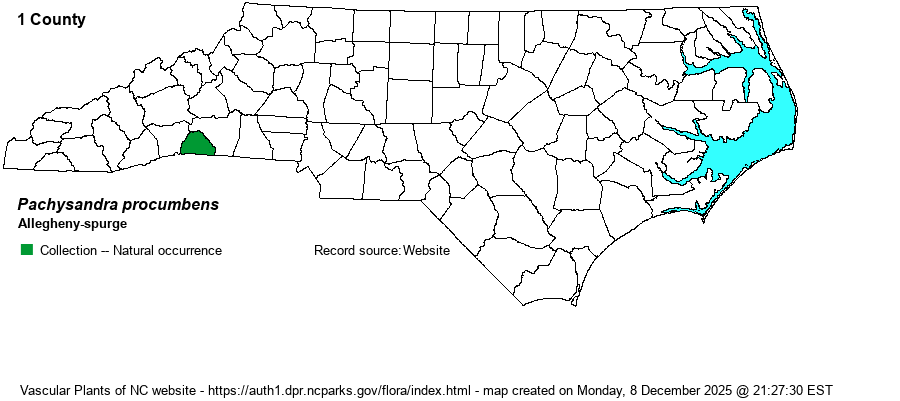| Author | Michaux | |
| Distribution | Historically and currently, only ever known from just a single county in the southwestern Piedmont (Polk). There are three sites (of four) that are considered by the NCNHP database as current. Photos from iNaturalist, even where correct, are presumed to be at planted sites; none of these additional counties are included on the map.
This is a species essentially based to the west of NC, in the south-central states. It ranges from KY and southern IN south to northern FL and eastern LA. There are only a few county records for NC, SC, GA, and FL. | |
| Abundance | Rare in a small area of Polk County; absent elsewhere in the state. Not surprisingly, this is a State Endangered species. Apparently one site is protected with a conservation easement, but none are owned by a conservation entity. | |
| Habitat | This is a species of very rich wooded slopes, over circumneutral soils. All sites are probably in Basic Mesic Forest natural community. Other rare or uncommon plants tend to occur with it in Polk County. | |
| Phenology | Blooms in March and April, and fruits in July and August. | |
| Identification | This is a rather unique species in NC, with no close relatives. It is a low-growing evergreen herb, growing only to about 6-8 inches high. The stem is often leaning or lying near the ground, with a number of alternate (but crowded on the stem) leaves. Each leaf is leathery, blotched in dull purple and pale green by late fall and winter, widely ovate but with many large serrations, to about 2.5 inches long and 2 inches wide. In early spring, new and greener leaves emerge and the overwintering ones wither. At the base of the stem is the odd flowering stalk, which is fleshy pink; it is a 3-4 inches long white and fleshy spike, with numerous flowers crowded on the colored spike. The flowers lack petals and sepals and are male only and female only; the male flowers are on top of the spike and the females below them. But, the stamens and pistils are thick and supply the white color to the flower cluster. Even without the flowers, the strongly mottled and widely ovate, toothed leaves are a dead giveaway to the presence of the species. Though the species has been known in Polk County for over 60 years, protection of the species in the state has been slow in coming, and its existence over the next decade or two is precarious without more conservation. | |
| Taxonomic Comments | None
| |
| Other Common Name(s) | Mountain Pachysandra | |
| State Rank | S1 | |
| Global Rank | G4G5 | |
| State Status | E | |
| US Status | | |
| USACE-agcp | | |
| USACE-emp | | |

